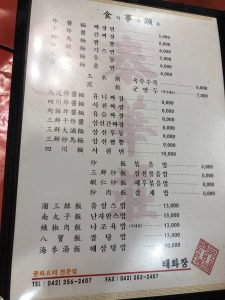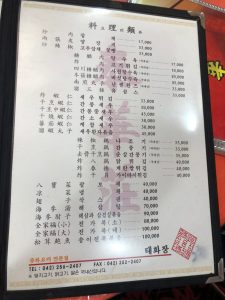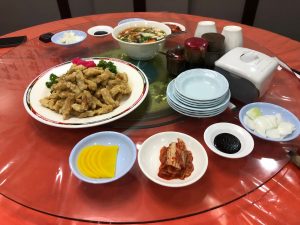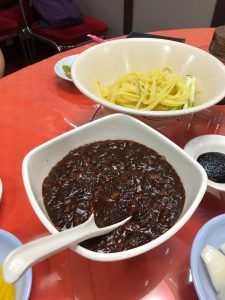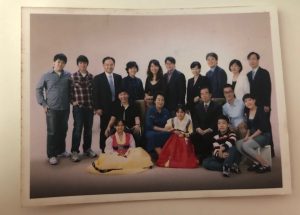Introduction – The Start
The instant ramen noodles that we know today was first invented by Japanese. inventor Momofuku Ando. In 1958, he dehydrated seasoned noodles in oil heat to create the texture of the instant noodles, which allowed the noodles to be reheated in hot water in a matter of minutes, quickening the process of noodle making and eating. This revolutionary way of consumption set ramen apart from any traditional noodles, and rapidly spread throughout Asia, Europe and other parts of the world. It was introduced in Korea as well after the Koran War.
The 1960’s after the war was rough to all the citizens of Korea. Industrialization had not taken place yet and many were in poverty, barely being able to scrap anything to eat today. According to my mother Sang Eun Cha, who grew up in the 60’s and 70’s, ramen had a place in society for the impoverished people. Rice instead was a symbol prosperity and those who could afford to eat it every meal was considered privileged. When people said they ate ramen today, it would even evoke sympathy to others.
However, as the years passed and many in Korea were able to enter the middle class, ramen slowly molded into a different meaning. My mother was especially surprised by how drastically the meaning of ramen changed from a symbol of poverty to a symbol of Korea. In this essay, we will delve into how much ramen today has become integrated as a common dish in Korea and how much of its DNA has manifested in the Korean culture.
Ramen DNA Manifested in Korean Culture
The DNA of ramen is expressed in countless cultural aspects of Korea. First, the meaning of consuming ramen for college students can be a metaphor of laziness and loneliness. Because cooking ramen takes about 8 minutes max, students resort to eating it in order to save time and effort. The less complicated cooking and cleaning methods appeal to these young adults with barely any time to spare. There is a bit of prejudice when one says they ate ramen for lunch. Friends may reply something similar to these: “Wow, you’re such a lazy bum,” “Get off your butt and eat a real meal!” Not used to offend anybody, conversations such as these take place very often as ramen can be seen as almost the last resort to meals. However, because people eat ramen regularly, this attitude does not particularly antagonize or target individuals who eat ramen.
This meaning can be found reflected in pop culture. In 2013, the song “Ramen Again?” by Akdong Musician hit the top charts in Korea because of its relatable lyrics. The song talks about a dry, slow-going day someone is having. With a lack of desire to do anything, they simply contemplate about what their next steps should be. When the motivation to do something is just about to materialize, they end up eating ramen instead and resort back to their lazy life. Many students have resonated with this daily routine, as ramen stands as a symbol of laziness and indifference to life. This shows how much ramen is related to the culture of Koreans and how it can be used to relate and possibly even integrate all those who have been in the same situation.
Ramen can be also extremely helpful to the same audience above: as hangover stew. Many college students also eat ramen as a quick and easy method to get over that grudgy feeling in the morning after alcohol consumption. The alcohol culture is especially large in Korea for young adults; many college organizations hide behind the name of extravagant titles but instead are actually excuses for drinking. Research has reported that an average college student drinks at least one standard drink per day. To save them from the massive aftermath, people eat ramen. Although not scientifically proven, many have said that the spicy hot soup helps calm the stomach in the morning. They also state that the familiarity of ramen provides them with reassurance that they are eating something Korean. Very different from how ramen was viewed above, ramen as hangover soup is a all-cure remedy to many who are prone to excessive drinking in Korea.
The concept of ramen is also used in a daily funny pick-up line. The phrase “Do you want to eat some ramen before you go?” metaphorically means the same as “Do you want to stay overnight and have sex?” It portrays ramen as a tool for seduction. After the phrase was used in the Korean Saturday Night Live back in 2013, it went viral among young adults, and now people use the phrase and ramen as a symbol of temptation. One of the reasons why it became so popular was because of its provocative statement. Although it might not mean much in the Western culture, in Korea, talking about sexual culture openly was considered taboo and not a norm in the deep-rooted conservative nature. The innuendo in this phrase used with ramen gave Koreans a nudge of familiarity and comfort that nullified that sexuality. I personally thought it was a good breaking out of the shushed sex culture and stepping into the freedom of expression, therefore progressing forward into the future. Funnily enough, ramen had a considerable part in this progression, and thus can be observed how much ramen has also helped shape culture.
Another identity of the ramen is its usage as an emergency ration food in Korea. Due to its long durability and quick cookable nature, ramen is easily delivered as a replacement energy source to affected disaster areas. Homeless shelters also ask for any leftover ramen as donations for food. In the Korean TV Show “Sports,” where celebrities hold various sports games, the producers asked each individual audience member to bring one pack of ramen as an entrance fee, of which they would donate to the nearest homeless shelter. This method was most likely not that difficult because most Koreans always have a stack of ramen in the house as emergency food. In the storage basement of my home, we have a whole cabinet filled with a variety of ramen. I remember as a kid, whenever our family ate some of the ramen on a weekend, the cabinet was quickly filled to its capacity. It never became empty. From this, it can be inferred that Koreans believe the ramen is a soul food that can energize them at the worst occasions.
Slightly different from all the meanings mentioned above, TV commercials for ramen are portrayed very peculiarly in Korea. In these ads, one can always observe a group of two or three smiling family members at a proper dining table, slurping ramen noodles from fresh white porcelain bowls alongside extravagant side dishes. The ramen can be observed as the main dinner dish. There is a sense of happiness and family that is evoked from consuming ramen in these short 30 second videos. While that may be true for Koreans, the choice of using ramen as a replacement for an actual meal is quite unique. Despite the prevalence and popularity of ramen in Korea, it is still not considered to be a completely filling or nutritional dish, definitely not enough for a proper meal. Instead, it is more of a snack or a poor alternative to lunch or dinner, due to the purposeful fortification of unhealthy chemicals in instant ramen. People also tend to be less formal when eating ramen, such as eating straight out of the pot, crouched on the floor, or without anything else except kimchi. The clean white bowls and multiple sides observed in the commercials are contrary to real life, as Koreans like to save the delicate china and spend time making other foods for “real” meals. Nonetheless, these ads are enticing people to eat ramen as authentic meals. I personally thought this portrayal was very intriguing because whilst it may not be accurate, it is a metaphor of how ramen has manifested itself as a proper dish in Korea. People do treat ramen as a common source of food, despite its lack of nutrition, because it is cheap and easy to make. Surprisingly, these ads are what truly reflects how much of a large part of ramen occupies the Korean culture and how much it has manifested as a ‘proper’ dish.
Development of Meaning of Ramen in the Recent Decade
Gradually, as the younger generation becomes appealed to the fitness lifestyles, people desire healthier alternatives to fast and junk food. In America, this manifestation can be observed in a lot of vegan foods, gluten-free bread or milk substitutes. Korea, instead of creating replacements for ramen, decided to change the ramen noodle itself to attract the same audience who are now willing to make healthier choices. While the reputation of ramen had been confined as an unhealthy meal in the past, the new nutritional ramen developed today has changed that notion. In an interview with personal trainer Mr. Sang Park, he said, “I have a lot of clients who are especially tempted by that one bowl of ramen at midnight. If they really can’t contain themselves, I tell them to eat gonyak ramen instead.”
Used traditionally in Japanese cuisine and Chinese medicine, konjac, otherwise pronounced as gonyak in Korean, is a plant whose roots, called corm, are high in the dietary fiber glucomannan. Konjac can be incorporated into noodles after it has been ground down into a flour-like texture. The plant is pretty much a superfood: it is known to keep blood sugar and cholesterol levels low, improve skin and gut health, help heal wounds and promote weight loss. These health benefits show why konjac products have suddenly begun appearing in grocery stores and thriving in sales. It has especially become increasingly popular in Korea as the ultimate diet ingredient. Popular ramen companies such as Pulmuone and Nongshim have used konjac in a new series of instant noodles. It is quick to serve, requiring only a few minutes in hot water to be ready, just like real ramen. This type of ramen became famous quickly among dieters, as one could have the experience of tasting real ramen with better health benefits.
This truly shows how Koreans’ love for ramen cannot be contained. No replacements can match the long-term embodiment of ramen in Korean culture. Like in the case of konjac ramen noodles, depending on the state what makes up ramen may shift depending on what the society favors currently; however, the core manifestation of ramen in Korea remains intact throughout all.
Meaning of Ramen Inside the Army Base
In South Korea, there is a military conscription for men, in which all males above 18 must serve in the army for the course of 18 to 24 months, depending on their base. Even inside these army boundaries, the ramen dish continues to prosper. Having had the chance to interview a real Korean soldier, I was able to discover what ramen means for almost 50% of Koreans in these special conditions.
“Ramen is a delicacy to soldiers.” This is what KATUSA(Korean Augmentation to the United States Army) soldier Sungmin Choi replied when I asked what ramen means to him. Ramen is rationed out to soldiers as special treats after difficult trainings, and Sungmin said sharing these snacks with comrades who also endured the same hardships became the most memorable times and helped create special bonds. He also mentioned that the ramen is associated with “outside” food, and makes soldiers feel one step closer to home. During the Intensive Training sessions in KATUSA, trainees and soldiers are not allowed to contact people outside the base nor are they allowed to leave. For 8 weeks, they are confined to army foods that are mostly bland and simple. Thus, being able to taste the flavorful ramen brings nostalgia to these soldiers of the outside world. “We treasure it like no other. Not just the food. It’s a time where we can come together and just be boys again, talking about ramen and mindless things,” explained Sungmin. Ramen inside the army base truly means more than just another source of food. Associated with happiness and reminiscence, ramen for these Korean soldiers are manifested as a food for the soul.
Conclusion
For each individual, there may be slightly different ideas in what ramen means to them. Ramen manifests countless identities to Koreans, from hangover soup, to diet products, to emergency rations. Ramen is so embodied in Korean culture that it cannot separated thus far. It definitely became a source of fuel one can’t live without, not just the food itself, but also the emotions and meanings it is evokes. Settled in as a common and popular dish in Korea, ramen has not lost its popularity within the many grandiose foods over the course of many years. Although at the beginning, it may have had a rocky start, it being a symbol of poverty, ramen now has a great deal to offer in Korean culture with many positive influences and manifestations that shapes the Korean individuals to who they are today.
Citations
Alper, Tim. “Instant Success: Why Koreans Are Crazy for Instant Noodles : Korea.net : The Official Website of the Republic of Korea.” Korea.net, Korea.net, 13 July 2016, www.korea.net/NewsFocus/Column/view?articleId=138467.
Akdong Musician. Ramen Again? SBS Kpop Star Season 2, 2013,
Burgess, Lana. “Konjac: 6 Potential Health Benefits.” Medical News Today, MediLexicon International, 11 Nov. 2017, www.medicalnewstoday.com/articles/319979.php.
Cha, S. (2019, August 1st). Personal Interview
Choi, S. (2019, August 4th). Phone Interview
CoCo, Ad, director. 1986-2016 농심 신라면 辛ラ-メン 광고모음(Nongshim Shin Ramyun Ads Compilation). YouTube, YouTube, 20 Nov. 2017, www.youtube.com/watch?v=rcHIKTcJwOI.
Edwards, Phil. “How Momofuku Ando Invented Instant Ramen – and Transformed Japanese Cuisine.” Vox, Vox, 29 Sept. 2016, www.vox.com/2015/3/5/8150929/momofuku-ando-ramen-instant-noodles.
“Korean Ramen Noodles – History & Facts of Ramyeon.” Bens Independent Grocer, 28 Apr. 2019, big.com.my/blog/korean-ramen-noodles-history-facts-of-ramyeon/.
Park, S. (2019, August 2nd). Phone Interview

